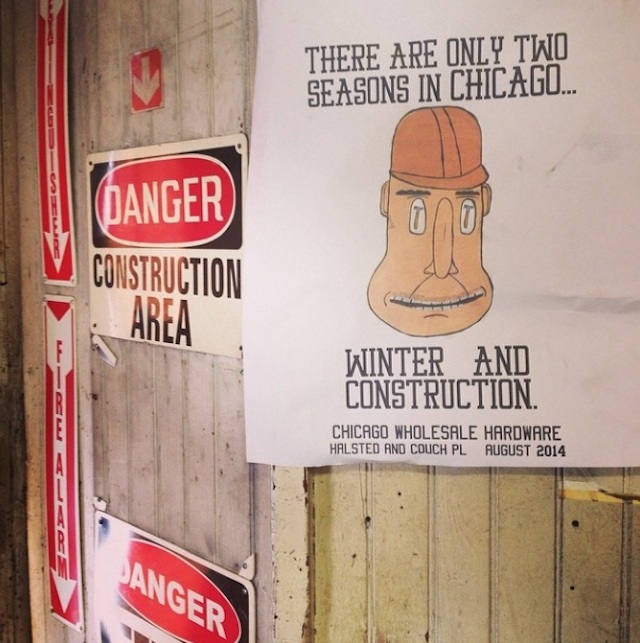
A note from RJ: I want to thank Dont Fret and Anna Cerniglia for putting this interview together. I’ve been a fan of Dont Fret’s work for a while, but since since latest show was really about a Chicago neighborhood that I’ve only very briefly visited, I asked him to find a local friend who might be able to have a conversation with about the project. Anna Cerniglia of Johalla Projects stepped up. Dont Fret has shown at Johalla Projects, and they helped put on his latest show, which is largely the subject of this conversation. A big thank you to both of them for letting me just step back on this one and do little to no work to read something really interesting. – RJ
Earlier this year, Dont Fret was given the opportunity to paint the walls of a building in Chicago’s Fulton Market. The building had previously housed a wholesale fish Market and a hardware Store, and with both businesses moving or closing, the building had been sold and was set for demolition in late August. Over the summer, Dont Fret painted the walls of the building and mounted a show inside the now-defunct hardware store entitled There Are Only Two Seasons In Chicago: Winter And Construction. The show featured a body of new work from Dont Fret, much of it made using materials found at the hardware store. The show was open for one week and then the hardware store was demolished on August 29th, 2014.
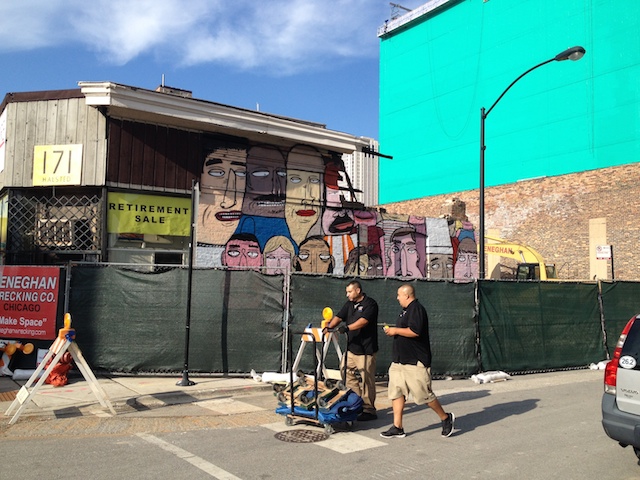
Anna Cerniglia: How have you been feeling after de-install of the show?
Dont Fret: I’m feeling pretty alright. People keep asking me if I’m bummed that the building is being torn down, but I am mostly just kind of in shock that we actually pulled off the show without anyone shutting us down. It kind of feels like the show hasn’t happened yet because we were in limbo for some time, there were just so many opportunities for something to go wrong.
AC: GOD RIGHT.
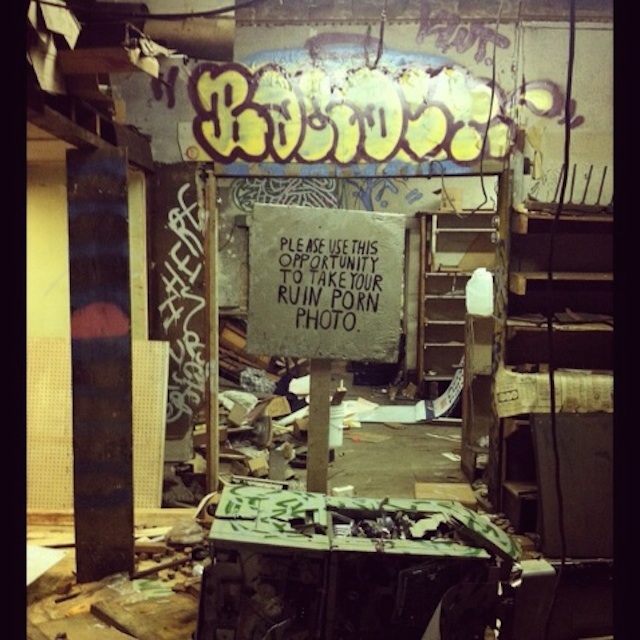
DF: How did you feel when I first showed you the inside of the hardware store? It was kind of a shit show.
AC: Well after helping produce an event in a similar space earlier this summer for Soho House, I wasn’t intimidated by the build-out. I was more intrigued with what we had to work with. The space earlier this summer I worked on was filled with refrigerators and ovens and all kinds of crap. It was storage. The hardware store was just a space frozen in time. I was afraid to touch it. It was amazing.
How about you?
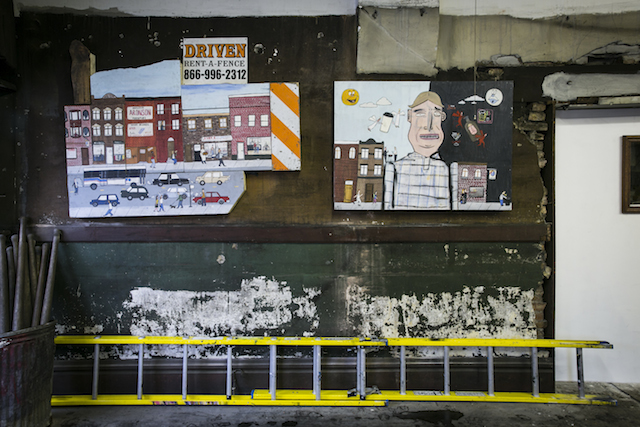
DF: And what the show ended up being was really far removed from what we had originally planned. Originally I didn’t want to touch anything, I wanted all of the original shelves and storage to stay, I wanted almost a precise time capsule, and none of that ended up staying because of scrappers and other people who were salvaging things from the space.
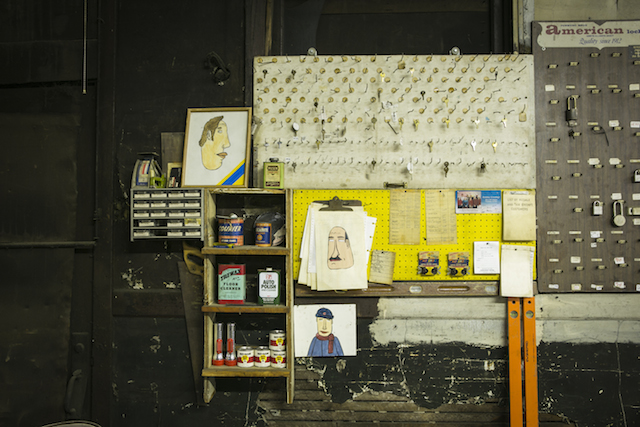
AC: Yeah I think it was even better though. The amount of space was perfect for the time allotted. And even though we lost those shelves the space felt exactly the same. I had so many people say “this is the best show I have seen this year.” I think that says a lot. The space wasn’t a white cube and the artwork fit into this timeless space.
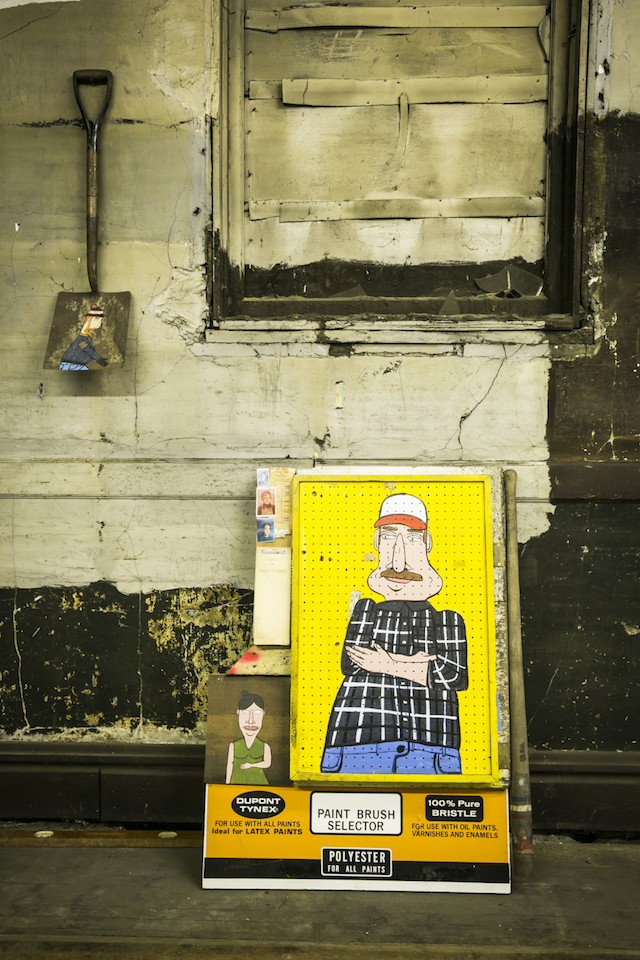
DF: I think so too. The first moment I set foot in the hardware store 4 months ago I knew I wanted to do a show in it. I haven’t done a solo show in a year and I knew that whatever my next show was, I didn’t want it to be in a traditional gallery space. I wanted to really create a moment and let the space live it’s life. Get closer to “real life” and maybe blur the line of what most people call a “pop-up art show.”
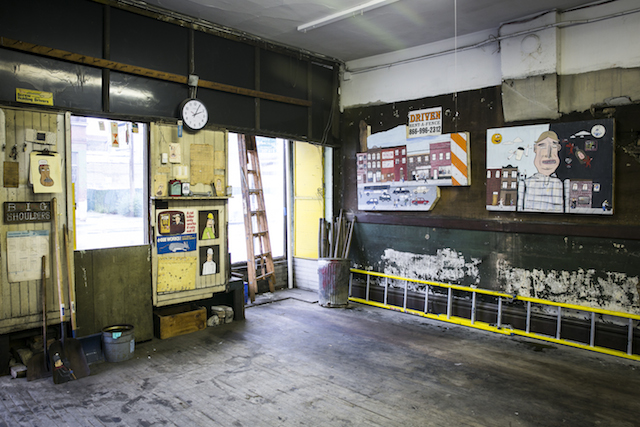
AC: Yeah – I have been hearing that term used so much recently. Where people take the white gallery cube and throw some wallpaper on it and call it a “pop-up.” But this was different.
DF: For me one of the best moments was when we re-painted and re-hung the “Chicago Wholesale Hardware” signage outside the shop and people started coming in asking if we could make keys for them or if we had Paint & Primer. We also set up a voicemail for the hardware store that people could call in and leave messages to. I think people were legit disappointed and confused that they couldn’t get keys made or order paint.
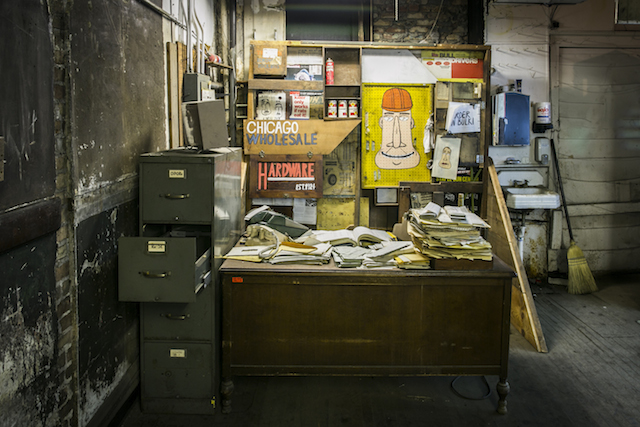
AC: I think the whole experience of having a historical presence in the space, and having you collaborate with it is what made the show different and successful. I had a good friend walk by during the opening and tell me how sad he was his hardware store was gone.
DF: Yeah I mean the store was open a long long time and it was one of the last original stores in the neighborhood, or at least certainly one of the oldest. The hardware store was at the corner of Halsted and Couch Place in the Fulton Market neighborhood and that area is definitiely “up and coming” as they say. There were so many people that came into the space just to say goodbye to it and share stories about shopping there.
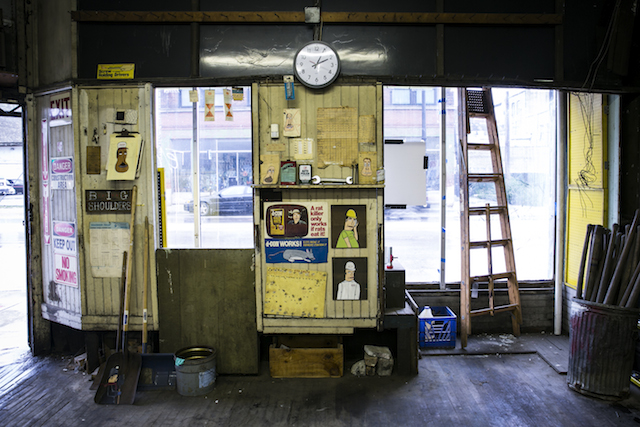
AC: The store was open almost 80 years right?
DF: Yeah, there had been a hardware store there since the 20’s from what I was told, but then the current owners family bought the space in the 50’s. We found packaged asbestos that was for sale in the back.
AC: Gross. And there was a fish market in the building also right?
DF: Yeah, traditionally the neighborhood has housed a lot of meat packing plants, butchers, wholesale produce vendors, and fish mongers. A pretty good amount of those businesses still remain but there is definitely a transition in the neighborhood. It is becoming restaurant row for Chicago. So I really wanted the murals on the outside of the building to reflect the history of the neighborhood and the types of people who worked here.
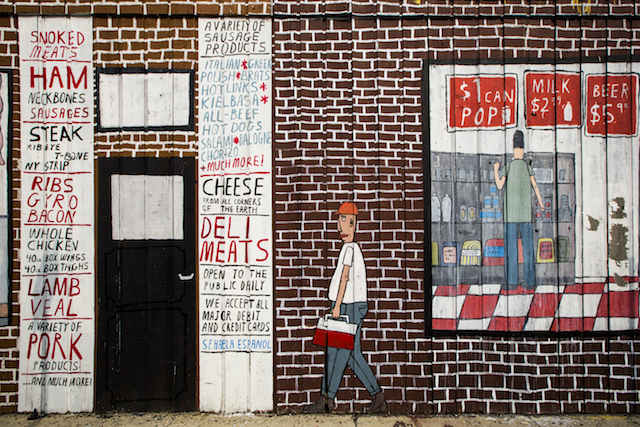
AC: And I think a lot of the people still around in the neighborhood really liked that. There was a story someone told me about being able to walk past a dock door and see a pig getting butchered.
DF: haha really?
AC: Yeah.

DF: I mean for me that’s like nearly as Chicago as it can get. That’s what I love about the neighborhood. When I lived there in college I would bike home at 5 AM from the Flatiron in Wicker and the sun was coming up and Fulton Street would be covered in blood and the guys would be bleaching the streets clean.
AC: Oh The Flatiron.
DF: Yes I know you love that place so much. I’ll probably be having shots of Malort with Tasso pretty much directly after this interview is done haha.
AC: He’s a good dude.
DF: That he is.
AC: He is also on the “People In Your Neighborhood” wall isn’t he? Why did you paint those people? Did you use that wall to reflect anything about the neighborhood the way the Halsted wall did?
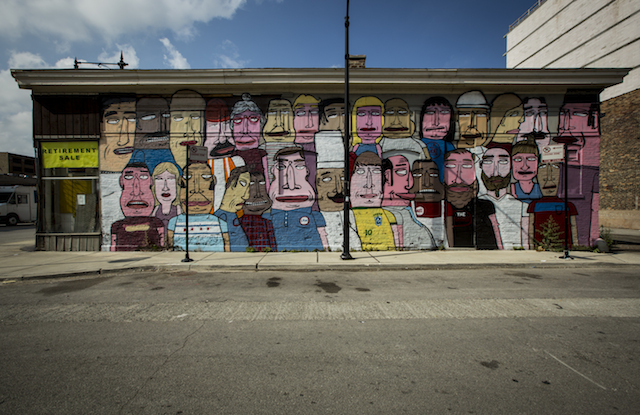
DF: With both of these walls I moved left to right in progression, which very rarely happens for me. So with the “People In Your Neighborhood” I just kind of started painting people. I rarely paint specific people, so it was more just like neighborhood archetypes. “Here’s the guy from JP Grazianos, here’s the guy from BARI Foods, here’s the construction worker, here’s the hot dog guy, here’s the meat packer.” It was more like shout outs in a way, but people walking by kept asking me to paint them in the mural. So eventually it got a little more specific and I threw in portraits of a few of my favorite Chicagoans. But I think the types of characters I have really gotten into creating in the past year have been of that breed, the kind of Chicago working jackasses, the union guys, the service industry, contractors, meat grinders etc.
AC: People who actually make Chicago what it looks like.
DF: Yeah.
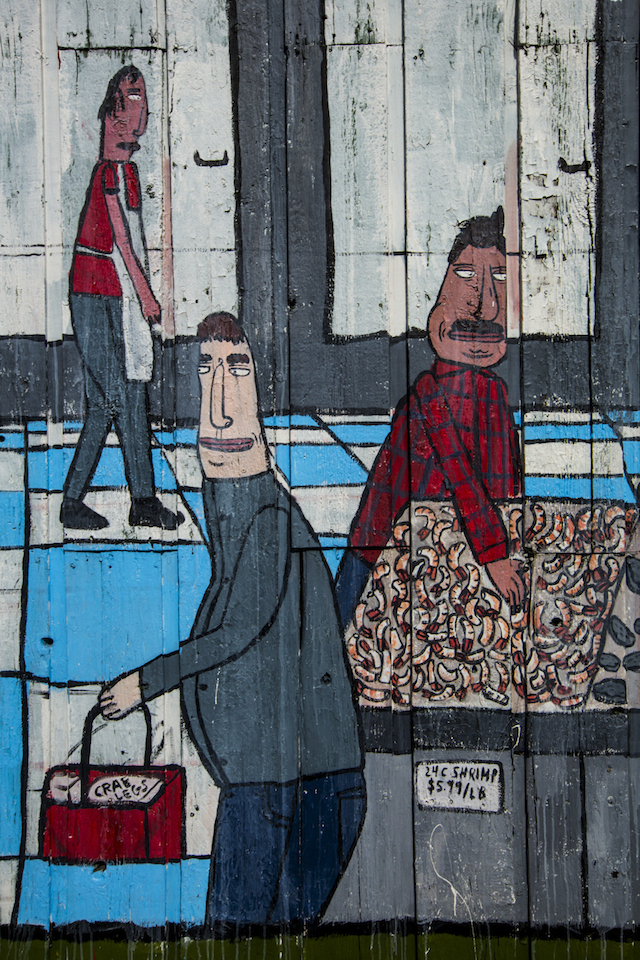
AC: Haha, I feel like everyone you just named is a staple in Chicago. I mean if you haven’t been to Bari Foods where have you been?
DF: BEST ITALIAN IN DA CITY.
AC: And since you’ve started painting these kinds of “staples” and a few of your guys look like they would actually own a hardware store, don’t you think that’s why your work placed well within the store?
DF: I think I was prepared. A lot of the characters in the store were based on guys my Dad used to work with as a plumber and contractor.
AC: And there was so much stuff in that store to use, did that lead your work in a different direction at all?
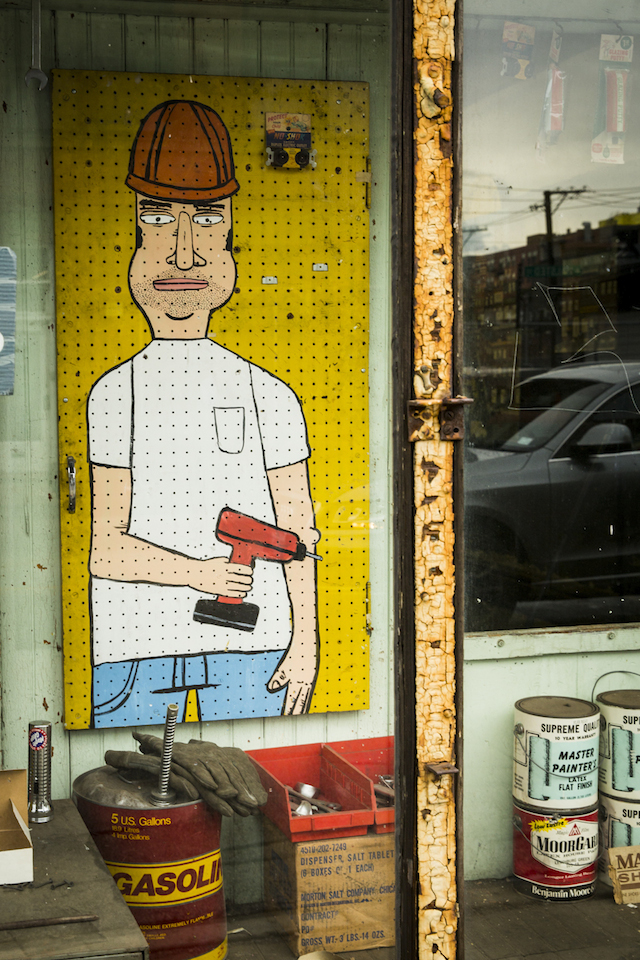
DF: The past year or so has been kind of transitory because now nearly all of my work is on found objects. Whether that’s wood, lotto tickets, found paper, etc. So being given access to this space and literally tons of vintage signage, wood, paperwork, cans of paint, and other equipment. It was hard not to be inspired by the space and the objects. This was also the first big project where I had Ryan (my carpenter extraordinaire) around full-time and we got to really experiment with the materials available and make some of the pieces more interactive. More moving parts. More ambitious by my total lack of craft standards. And because the work was nearly all made with salvaged material from the space it was really harmonious. It was a really fun collaboration. How did you feel this show fits within what’s happening in Chicago art show wise?
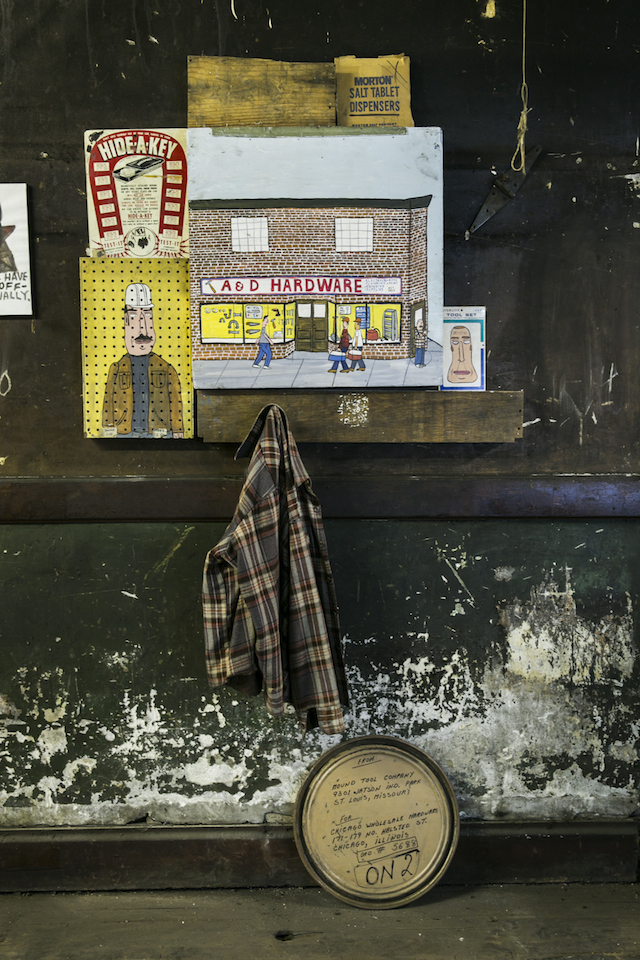
AC: I have been trying to pull work out of galleries for years and I feel like the more we do it the more people are receptive to it. Everyone always reacts to murals and public art in the same way they have for years and sterile gallery environments are always going to be popular. But lately I think people are starting to want something different and wanting more of these “pop-up” activations. Shows with a short lifespan. Are you used to your work (both in the street and in the gallery) having a short lifespan now?
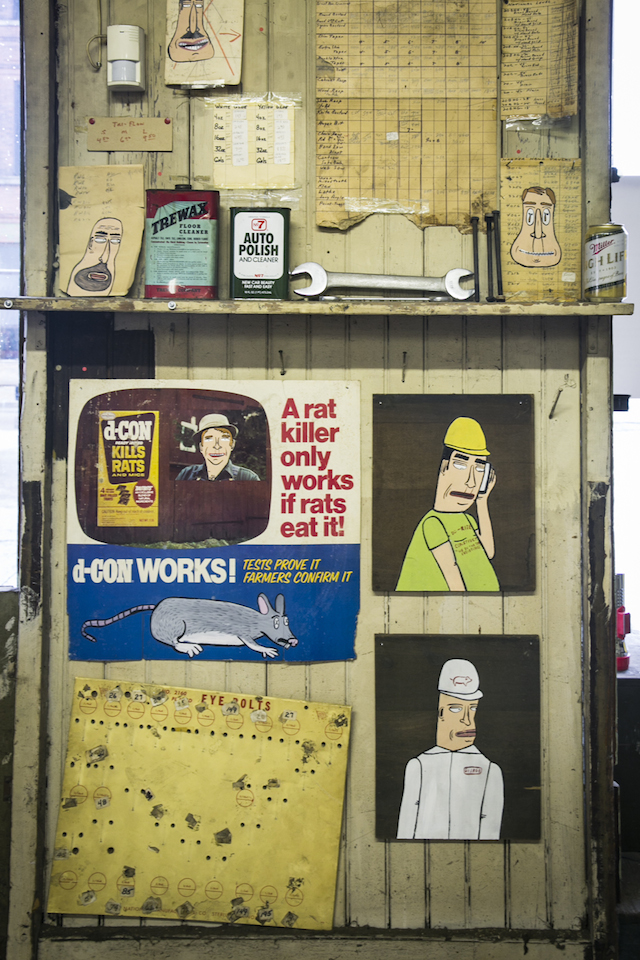
DF: I think that was just kind of the way the game was explained to me and I’ve lived by those rules since. If I had to guess I’d say 98% of anything I’ve ever put up in the street doesn’t exist now. I think that’s affected the way I approach “gallery” shows. Most of the gallery work I make is made for a specific site or theme, so for now I rarely show a piece more than once in a show. And the murals were kind of the same. I came in knowing the building was being knocked over August 25, so I do my work, it lives it’s life and then we move on. In a weird way I’m almost happier I get to outlive my work as opposed to the other way around.
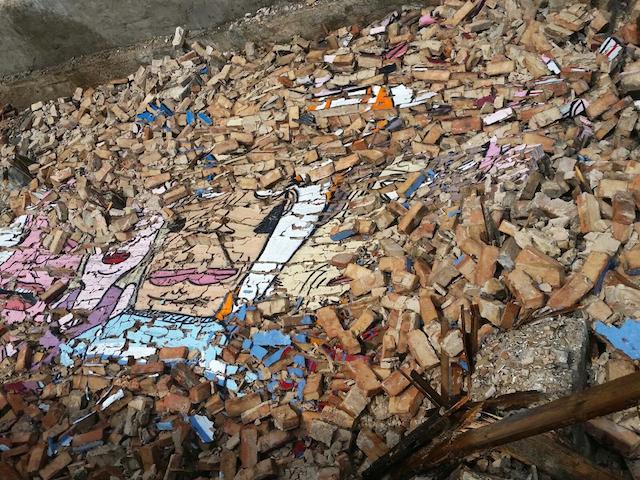
AC: Do you think other street artists in Chicago feel the same way? The real question actually is how many of these people do you think will be around in 5-10 years?
DF: It’s really hard to say. I think there are a lot of people in Chicago “dipping their toes in the water” with “street art” so to speak. Especially with wheat paste. And I say “street art” not really believing in that word but acknowledging that it is different than “graffiti” which has a storied history here in Chicago. “Street art” is still new here. It’s probably like any major city. There are amazing artists here who have been putting up work for years. Then there are some kids who are new and hungry and show promise and then there are a lot of people who are approaching “street art” as a hobby, or as a marketing ploy, or as a way to use Chicago as their own personal refrigerator.
AC: It’s difficult to filter through who wants to be an artist and who wants to be cool.
DF: And who is willing to continue putting up work in the streets after being arrested 2-3 times.
AC: Who in Chicago do you think is doing it right?
DF: Left Handed Wave is the only person I know who’s put up 1000 (literally 1000) stickers in one night. Nice One & Lucx’s collab efforts get me more and more excited every time I see them on the streets and in the gallery. Clam Nation and Nudnik kill rollers. RIP Brooks Golden. I wish I had a 1/4 of the talent Amuse 126 does. On an administrative side Nick Marzullo and Pawn Works will be the stuff of legend someday in Chicago. It’s incredible how much they’ve done for the scene here.
AC: We will forever miss Brooks.
DF: Yes we will.
AC: You did a lot of traveling this year and a lot of “legal-walls” in other cities this year, is more of that next?
DF: I can’t do the same thing for too long. I have been pasting in other cities along with doing murals, but I’m ready to focus on that kind of work again for a bit. Construction season is ending, winter in Chicago is coming, and I’m kind of excited that “mural” season is ending and “vandalism” season is beginning.
Photos courtesy of Dont Fret
